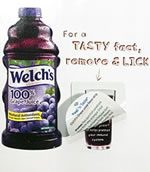One of the challenges retailers and consumer product marketers face is how to keep campaigns fresh and different, while compelling consumers to take interest in products. Recently, the buzz is all about making sense out of marketing—with sensory marketing.
Hershey’s Chocolate significantly spurred sales at point of purchase with Scent Air Technology installed in vending machines in California tourist locations. Hersey’s reigned supreme over the other three brand choices as the company sold 300 percent more chocolate than the others.
In the Hard Rock Café Casino in Florida, an ice cream parlor was suffering from a lack of traffic due to its location. The parlor made moves to strategically fill the air of the entrance to the casino with the scent of ice cream cones, and the parlor immediately saw an increase in traffic and sales.
Welch’s made waves with its recent lickable ad campaign released February in issues of People Magazine. Readers were told, “For a tasty fact, remove & lick.” First Flavor, the company behind the lickable strip, is the proponent of Peel ‘n Taste, which provides consumers with information about a product’s taste without the expense required to mount a traditional sampling campaign.
Advertisement
While some may be skeptical, sensory marketing is not an entirely new concept. Retailers like Cinnabon certainly blow that sugary, buttery smell into the air in malls (whether they admit it or not!)
Marketing That Makes Scents
Traditional and historical marketing and advertising have focused primarily on visual impact, but a new-found focus on the sense of smell is definitely having an impact in the retail arena.
The sense of smell is a goldmine for marketers, says Harald Vogt, Founder & Chief Marketer of Scent Marketing. “The frontal part of the brain is responsible for decision making — and our sense of smell goes right into it,” says Vogt. “You can really generate feelings in people that other advertising approaches can’t. That’s why scent is the next key in advertising.”
With items that elicit strong brand loyalty — like toothpaste, for example — Vogt says scent marketing is ideal for sales as well as damage control. “Retailers can avoid spillage and product damage if consumers can smell the product without opening it.” Products offering scent-appeal also draw consumers away from competitive products, while catering to the customers’ attraction to entertainment and playfulness when they come into the store.
Before jumping on the scent marketing bandwagon, Vogt says there are limitations and barriers that retailers need to be mindful of:
- Electrical limitations. Scent marketing devices typically run on a battery because outlets aren’t readily available on shelves in retail stores.
- Adequate ventilation. Retailers need to be sure that the environment doesn’t smell of multiple aromas, rendering the anticipated positive effect as negative.
- Sensitivity to individual consumers: Consumers with allergies and hypersensitivity to smells could bring lawsuits, so the technology must be offered for voluntary participation from consumers, not as a push-out to the entire consumer population.









